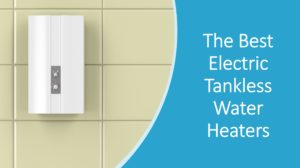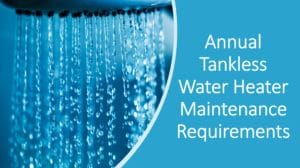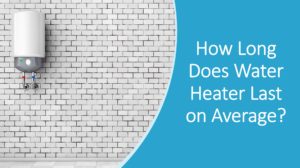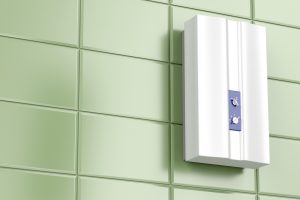There are many benefits that you and your family will enjoy once you install the best tankless water heater.
You won’t have to fear that your water heater is going to explode, there’s no tedious ongoing maintenance, and you won’t have to worry about replacing after eight to ten years of use.
You also won’t have to wait an hour to take a shower once all of the hot water has been used up, and you can install one of these powerful little water heaters pretty much anywhere, so space isn’t an issue at all either.
Making the switch from a traditional tank water heater to a tankless unit can be difficult. Aside from the complicated installation, there’s the high price to consider.
These models are usually much more expensive than a tank water heater, but once you learn more about the benefits, you’ll quickly realize that the added convenience and the fact that you’ll never again run out of hot water at the wrong time, can make the higher price tag totally worth it.
See Also : Best Electric Tankless Water Heater Reviews
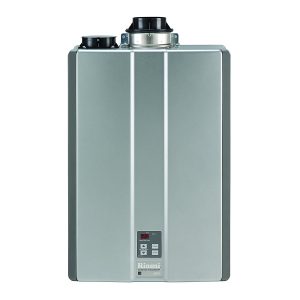
- Power Type: Gas
- Gallons per Minute: 9.8
- Weight (lbs): 82
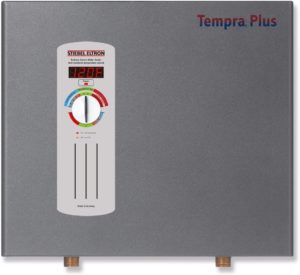
- Power Type: Electric
- Gallons per Minute: 4.37
- Weight (lbs): 10.37
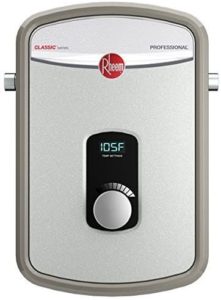
- Power Type: Gas
- Gallons per Minute: 9.5
- Weight (lbs): 4
Best Tankless Water Heater Reviews
1. EcoSmart ECO 27 Tankless Water Heater
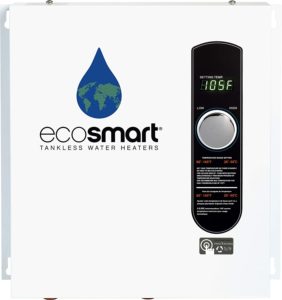
EcoSmart introduced their newest tankless water heater model; the ECO 27 and it’s already receiving rave reviews from homeowners and the pros. This is a highly energy-efficient water heater that’s best suited for a single family home. It’s self-modulating and offers precise temperature control.
It’s also equipped with a digital control panel that will allow you to use one-degree increments to adjust the temperature setting for the water output.
The manufacturer also claims that you can run up to one sink and a total of three showers at the same time, without running into water pressure issues. This is definitely an important feature in larger households.
The max flow rate comes in at 6.5 gallons per minute, which is decent in this price range.
When it comes to energy efficiency and the flow rate, this will be more a matter of climate, based on the temperature the water is at when it first enters the water heater. The higher the temperature at the inlet, the more efficiently and quickly the heater can handle heating up larger volumes of water.
Because this is a self-modulating tankless water heater, the unit will adjust the level of energy needed based on the volume of water that’s used and the temperature you have set.
The water heater will require two hundred and forty volts of electricity and it comes equipped with auto thermal protection to prevent the water heater from overloading or overheating.
- This water heater is ninety-nine percent energy efficient. Hence , only 0.2% energy is lost
- Weighing just under fourteen pounds, this compact, lightweight unit can easily fit just about anywhere, which is a huge selling point if you’re short on space.
- Unlike other models in this price range, the ECO 27 is highly adjustable, allowing you to precisely choose the water temperature you prefer.
- Relatively low maintenance, just an annual inspection is all this model requires.
- While considered energy efficient, it’s not Energy Star certified.
- In colder climates this water heater can struggle to heat up larger volumes of water if more than one shower is running at the same time and temperatures are below thirty degrees.
- Considering this model requires 0.75-inch NPT pipe fittings, and most homes do not use this size, we recommend professional installation.
Conclusion
This best tankless water heater is designed for whole-house use and should be able to easily handle producing large volumes of water, a big plus for any busy household.
Energy efficient, highly adjustable, and reasonably priced, this is a great buy for the homeowner on a budget who is looking to upgrade to a powerful tankless water heater.
2. Rinnai RUC98iN Ultra Series Tankless Water Heater
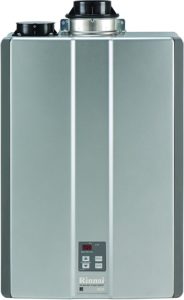
Rinnai’s newest line of tankless water heaters has been creating some serious buzz over the recent months, mainly because they’re said to be almost twice as powerful as other models in this price range and can run a number of water-based appliances in the home at the same time without any interruption to water flow. If you’ve done your research regarding tankless water heater limitations, then you know this is a big deal.
Because of this, we were excited to dig a little deeper to learn what this model has to offer and exactly how it can withstand heavy use without a dip in performance.
The RUC98IN by Rinnai is a gas-powered tankless water heater that comes equipped with digital controls located on the front panel. The control panel allows you to adjust gas and temp and also features a power button. Users can even lock the desired temperature setting, preventing other people in the home from making their own adjustments.
This model complies with basic emission standards for nitrogen oxide. In terms of venting options, the water heater includes both twin and concentric PVC pipes. The water heater features bigger than average water and gas supply outlets and inlets.
Equipped with an electric ignition system, the water heater will consume approximately sixty watts of power in standard mode and just two watts in standby mode. It also requires up to one hundred and fifty watts of power during the colder months of the year, to prevent the components from freezing.
This model is not only much larger than the average tankless water heater, but it also offers a flow rate of 9.8 gallons per minute, with a minimum flow rate of 0.4. Energy Star certified, it has an energy rating of 0.95 up to 0.98, which is also much higher than average.
- This model is powerful enough to provide hot water to multiple showers in use at the same time, without reduced water flow.
- It also offers a higher than average water temperature setting that ranges from ninety-five up to one hundred and forty degrees.
- This unit comes with a twelve-year warranty.
- Installation can be pricey. Unlike most tankless water heaters that require 0.5-inch water and gas connections, this model uses 0.75-inch MNPT connections.
- Ongoing costs can also add up because the water heater requires professional maintenance services by a certified Rinnai repair team. Failure to have the unit serviced by authorized repair personnel can void the warranty.
Conclusion
This model by Rinnai is highly efficient and can use both propane and natural gas. It’s built solid and offers a wide variety of venting options. However, installation can be tricky and the ongoing maintenance costs can be a deal breaker for some homeowners.
Overall, you’ll get a powerful water heater, and one that comes with an excellent warranty.
3. Stiebel Eltron 29 PlusTempra Tankless Water Heater

One of the most advanced on-demand water heaters on the market, this model by Stiebel Eltron features advanced flow control that’s exclusive to the Tempra line. This feature ensures constant temperature output, regardless of hot water demand, automatically adjusting the water flow in order to reduce or even eliminate fluctuations in water temperature.
This electric tankless water heater is designed as a whole house unit. The Tempra 29 is a total workhorse offering an impressive 4.37 gallons per minute. Users can also adjust the water heater to temperatures between eighty-six degrees up to one hundred and twenty-five degrees.
But despite its raw power, this model is surprisingly compact. Weighing in at just seventeen pounds, it can fit into the tightest space.
Because this is an electric water heater, you don’t have to worry about live flames, fumes, or vents. This is because unlike a gas-powered model, this water heater warms up the water using coils, not burners.
The heater’s digital interface is designed with convenience in mind and makes adjustments simple and fast. The included dial selector allows you to customize hot water delivery based on your preference.
It’s also low maintenance. Aside from an annual inspection, you can pretty much forget this water heater exists, unlike a traditional tank water heater that can require monthly maintenance.
- In terms of water flow and heat output, this water heater offers a 4.37 water flow, so you’ll never run out of hot water.
- This is an energy efficient model.
- According to the manufacturer, this water heater can lower your energy bill by as much as twenty percent.
- thumbs-upA powerful water heater, it can provide more than enough hot water to multiple showers at the same time.
- thumbs-upThe highly adjustable controls allow you to set the desired temperature down to the degree.
- You may experience a flow delay with simultaneous use, but this is common with every type of tankless water heater. If you run into this problem, you can simply adjust the dial until the desired temp and water flow are compatible again.
- thumbs-downMost homeowners reported that installation can be very complicated. We recommend allowing a pro to handle this process. Of course, you’ll need to consider the added cost of installation.
- thumbs-downFor some, this water heater was a little on the pricey side, but once you consider the raw power it offers and consistent water temperatures, you’ll quickly realize it’s a fair trade-off for on-demand hot water whenever you need it.
Conclusion
While it’s not perfect, the Tempra 29 is pretty close. There have been reports of reduced water pressure with simultaneous use, however, it has also been reported that this model can outperform higher priced models of tankless water heaters on the market. We recommend this water heater for larger homes and for homeowners on a budget who are in desperate need of an upgrade.
4. Rheem 95DVLN Indoor Direct Vent Tankless Water Heater
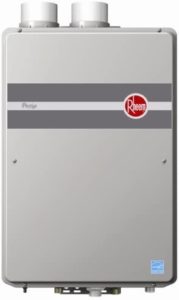
The 95DVLN by Rheem is the latest tankless water heater in their line. Right off the bat, we noticed it offers an impressive water flow rate of 9.5 GPM. This amount of water flow far exceeds competing models.
This unit requires 199,000 BTUs of power; however, power consumption shouldn’t be a concern considering this unit quite energy efficient. It’s so efficient in fact that it has a ninety-four percent energy rating. So, if you’re looking for a tankless water heater that will lower your monthly bill, this is the one.
This is a natural gas water heater, so it runs on live flames that work to quickly heat up the water. With this style of tankless water heater, you’d typically need a complicated venting system in order to ensure that there’s no buildup of fumes, but the manufacturer has made this gas-powered model a total game changer in terms of setup and installation.
This unit is equipped with a low NOx system, which means it can be installed anywhere, even inside, and you won’t have to worry about installing a heavy-duty stainless-steel venting system. Instead, PVC vents are all that is needed.
In terms of heating power, this model is designed as a whole house unit. However, if you want to install a second water heater to avoid the loss of water pressure when several hot water applications are going at once, it can also be fitted with cables that will link it to other units. This is the perfect solution for larger homes.
As we briefly touched on, the water heater’s flow rate is 9.5 gallons per minute. In extremely cold temperatures you can expect a short lag in the hot water supply, but generally, this model offers a top performance in most climates. That’s because it’s equipped to easily handle temperatures as low as thirty degrees without struggling. It can also work in elevations that exceed ten thousand feet.
- You’ll be able to easily adjust the temperature setting using the digital display found on the outside of the unit.
- The higher than average flow rate makes this model a great choice for larger homes.
- The water heater comes with detailed, easy to follow installation instructions.
- thumbs-upThe low NOx system reduces emissions and fumes.
- This model is priced pretty high, even for a standard tankless water heater.
- thumbs-downIf intended for commercial use, you’ll need to consider using multiple units.
Conclusion
A higher than average flow rate, easy installation, and the ability to precisely adjust the water temperature are just a few reasons to run out and purchase this model. Of course, it may not fit every budget, but the water heater’s reputation for durability, heating power, and overall quality will definitely make it worth the purchase.
5. Takagi T-H3-DV-N Tankless Water Heater
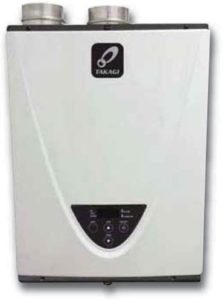
The T-H3-DV-N tankless water heater by Takagi offers an endless supply of hot water, is energy efficient, and comes equipped with computerized safety features.
Efficient and powerful, this model features an incredible flow rate of ten gallons per minute, which far exceeds any model in this price range. If you need plenty of hot water and you want it now, this model delivers.
This water heater runs on natural gas, so heat exchangers and internal burners will fire up once the sensors detect cold water in the pipes. While normally this would require vents due to intense fumes, this water heater doesn’t because it works with a condensing system.
Typically, natural gas creates steam which must be vented due to the dangerous fumes, but this model works by condensing the steam via a combustion chamber, turning it into water that flows out a drain.
As you can see, this model is totally changing how indoor gas-powered water heaters operate.
- A powerful water heater that can work for both commercial and residential properties.
- The built-in condensing system means you won’t have to worry about installing heavy-duty vents.
- This unit is more energy efficient than other models of gas-powered water heaters.
- It comes equipped with computerized safety features that are built right in, so you won’t have to worry about leaks or malfunctions.
- This water heater can also heat up water to impressively high temperatures. Most models will heat water up to one hundred and ten degrees, but this unit can heat water up to one hundred and eighty-five degrees.
- The flow rate it offers is reason enough to hit that buy now button and it’s powerful and fast enough to run multiple appliances and showers at once.
- Operation requires 199,000 BTUs to run this model at its full potential. We recommend consulting with a pro to determine if special parts are needed in order to enjoy the water heater’s full wattage.
- Weighing in at sixty pounds, this is a larger than average tankless model.
- Keep in mind that while the heater boasts an impressive ten gallons per minute flow rate, this can also heavily depend on the climate. If you live in a colder part of the country or you have higher than average hot water needs, then you’ll probably find that the gallon per minute rating runs slightly lower.
- Because of the heater’s drainage system, installation can be difficult, so we don’t recommend doing it yourself. Instead, leave the work to the pros. If you insist on doing it yourself to save costs, you’ll need to purchase ground wires, a valve kit, a hose, and a drain. You’ll probably also need an acid neutralizer kit.
- This tankless water heater doesn’t offer precise temperature control like other models in this price range, however, you can purchase a remote temperature controller that will allow you to adjust the temperature to the exact degree desired. The temperature control device must be Takagi brand in order to operate with this water heater.
Conclusion
While it may not be the most affordable best tankless water heater on the market, it’s by far the most powerful. This unit will keep your whole home supplied with hot water, even if you live in a colder climate. The leading gas-powered model in the industry, you can’t go wrong with this Takagi model.
Tankless Water Heater Buyer’s Guide
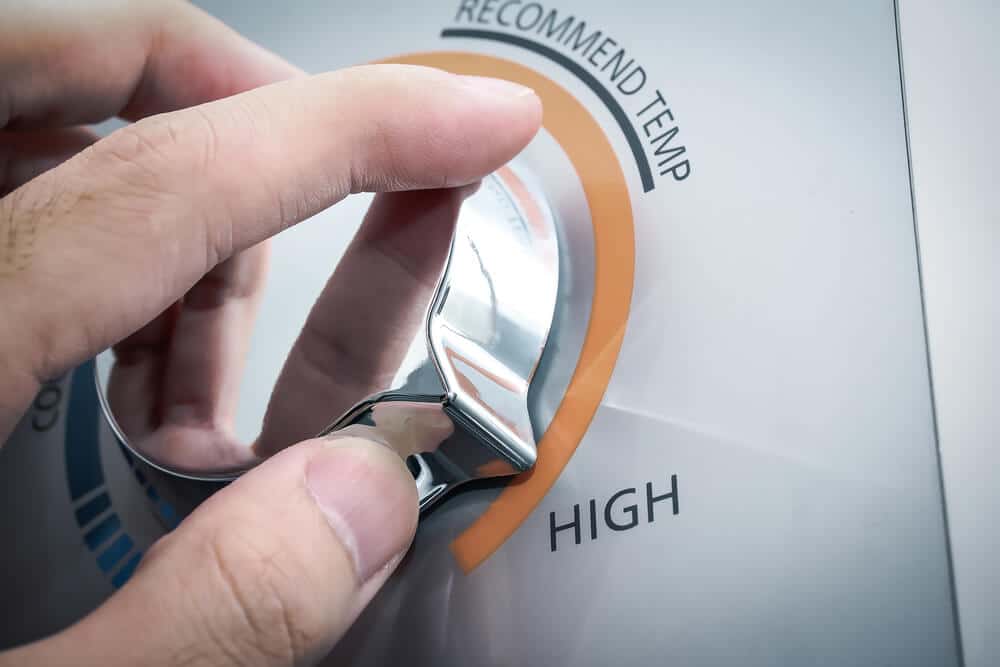
The best tankless water heater, also referred to as on-demand water heaters, utilize high-powered burners that work to rapidly heat water as it flows through a heat exchanger.
The water is delivered directly to your shower or faucet and will not store a reserve in a large water tank. These models can be powered by either gas or electricity.
Compared to a storage tank water heater, these tankless models are twenty-two percent more energy efficient.
That’s because a traditional storage tank water heater must keep the water heated twenty-four hours a day, in order for hot water to be readily available. Since the tankless water heater heats up water instantly, it doesn’t have to work around the clock to keep your water supply heated.
As you can see, the biggest downside to the traditional water heater is the amount of waste that goes into keeping forty to eighty gallons of water heated.
Instead of storing the water, tankless models will use a series of powerful gas burners or electric coils, which are referred to as heat exchangers. These heat exchangers work to quickly heat up the water as you turn on the faucet. Once the faucet is turned off, the coils or burners turn off as well.
These days, many companies now offer tankless water heaters that are available in a wide range of sizes and styles. From electric, compact, point of use water heaters, to larger gas-powered models that are able to quickly supply water to an entire household.
If you want to provide hot water to just a single fixture, such as the guest bathroom, then the point of use models are the perfect choice, but if you need a tankless water heater that’s powerful enough to handle heating up water for all of your appliances, showers, and sinks, than you’ll need to check out the larger, more powerful models.
Water Flow
With tankless models, you won’t end up emptying out the water heater, because it doesn’t have a tank to empty. So, it’s not a matter of determining the type of tank capacity with these models because you can enjoy an endless supply of hot water. Instead, you’ll want to focus on the water flow.
These water heaters won’t run out of hot water unless of course, the need for hot water by multiple members in the home surpasses the water heater’s heating ability. As an example, if you’re washing a load of clothes in hot water, and someone is taking a hot shower, the water heater may be unable to adequately heat the water because it’s flowing through the system too quickly.
So, what’s the solution? You need to search for a model that puts out a lot more heat. Pros also recommended staggering hot water use. A more expensive solution is to purchase a couple of tankless water heaters.
Tankless Water Heater Styles
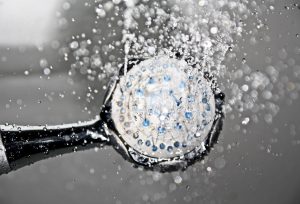
To start, you can buy either an electric or gas powered tankless water heater. Most experts recommend gas-powered models simply because they feel that they’re much more efficient, and they can definitely heat water up faster. But this style of water heater will require venting. Generally, their flues must be larger than the kind that are required for traditional gas-powered water heaters.
Some gas-powered tankless water heaters will feature power vents. These vents allow the homeowner to exhaust the gas out a side wall. This style is a great buy if running a new vent out of the roof is impossible.
Outdoor tankless water heaters don’t require venting because they can be installed outside the home. However, in extremely cold climates this type of water heater may not be very practical.
There are also some models of gas-powered water heaters that consume fuel in order to maintain a flame. Models with an electronic ignition can help in terms of efficiency. Search for a water heater that comes equipped with an intermittent ignition device. Or you can opt for models that feature hydro ignition, which consists of a small turbine that’s water-powered and sparks the burner.
Water heaters that don’t have a pilot light will be more expensive, however, they’re also more energy efficient, which means they can cut down on annual costs.
Warranty
Before you buy, always take a look at the warranty. The best models will work for twenty years since they don’t have a tank that will deteriorate after several years of use. A traditional water heater will only last about ten years before a replacement is needed. The heat exchanger in tankless water heaters is the most crucial component, and it will often come with a short five-year warranty.
Water Heater Size
When you’re shopping for a tankless model for the entire house, again, you must think in terms of flow instead of water capacity. As we have mentioned, tankless water heaters won’t run out of hot water like a traditional water heater can. Yet, they also won’t be able to heat the water up fast enough if several showers, sinks, or appliances that use water are running at once.
Energy Efficiency and Flow Ratings
Tankless water heaters are given a BTU efficiency and input rating. These ratings are what determines the flow rate, which is expressed in GPM, or gallons per minute.
Remember one BTU equals the amount of energy needed to increase the temperature of one pound of water a single degree. The higher the BTU rating, the higher the flow rate. Additionally, if you live in a cold part of the country, the water heater will need more time to heat up the water, so keep this in mind when you’re checking out the flow rate.
These flow rates often range from one to six gallons per minute.
If you’re concerned about annual energy costs, check out the unit’s efficiency rating. These ratings can range from seventy-five percent up to ninety-eight percent. The rating will indicate how much fuel is converted to heat, so the higher the percentage the better.
Advantages and Disadvantages of Tankless Water Heaters
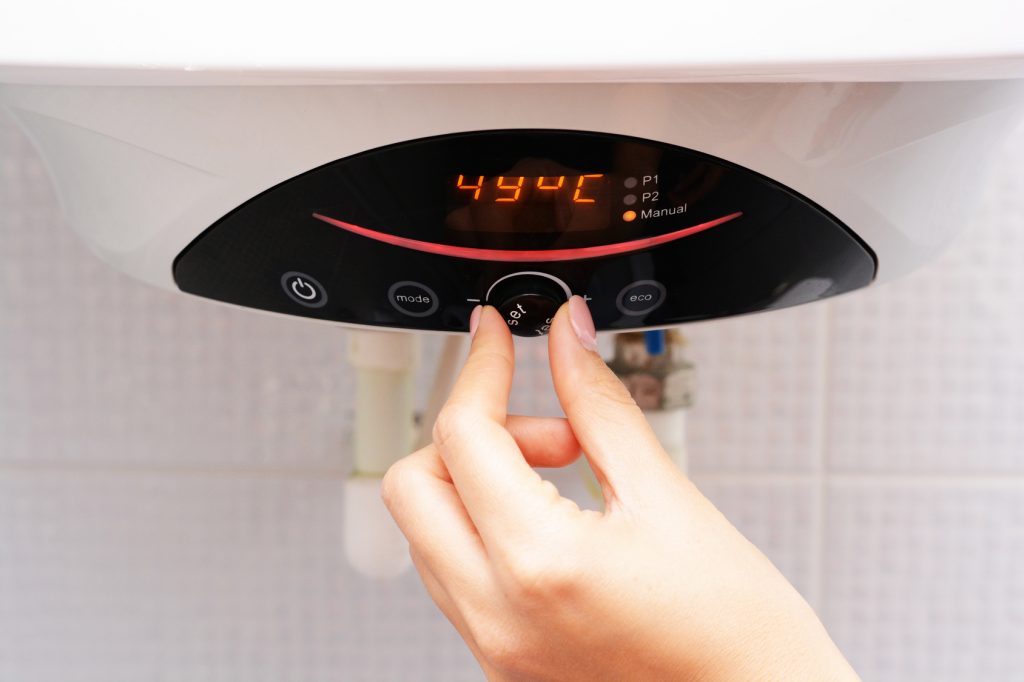
As you know, no product is perfect, and these water heaters are no exception. While they have many good points, there are some downsides as well.
Advantages:
- Tankless water heaters can save you hundreds of dollars a year on your utility bill.
- According to statistics, homes that use less than forty gallons of hot water a day can save up to thirty-percent more on their energy bill compared to homes that use a traditional tank water heater.
- Tankless models have a longer lifespan than storage tank water heaters.
- These water heaters are very compact and will only take up a fraction of the space that a traditional model will.
- You’ll enjoy a limitless supply of hot water.
Disadvantages:
- Higher initial cost compared to a tank water heater.
- The cost of installation for a tankless model is over twice the price of a traditional water heater.
- Water flow may be an issue in bigger households.
Choosing the Right Size
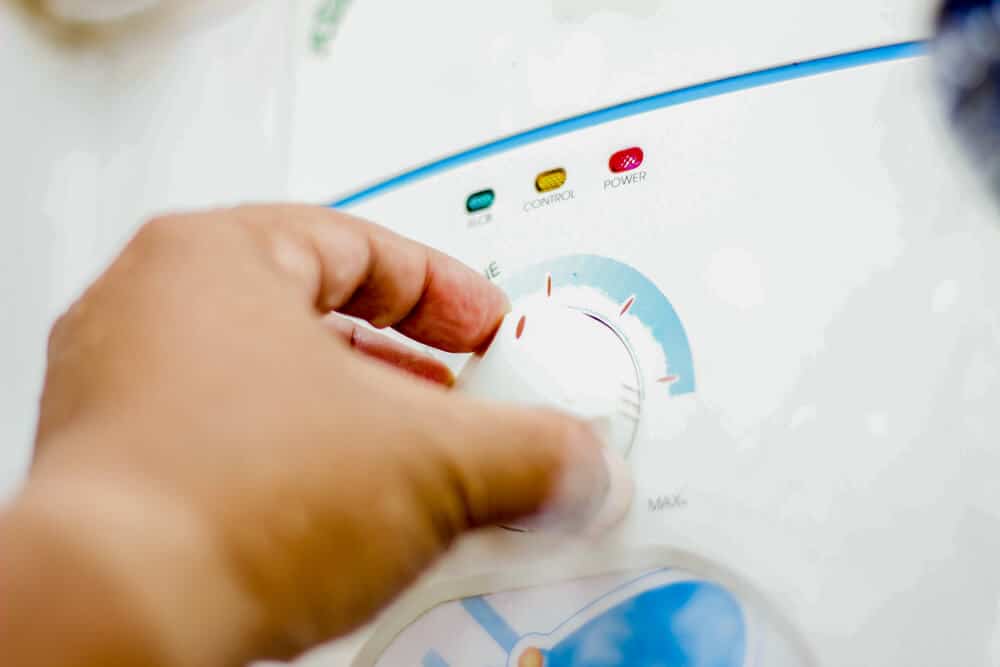
Tankless models are rated by the max temperature rise based on flow rate. In order to size an on-demand water heater, you’ll need to determine the temperature rise and the flow rate you’ll need for its application.
It’s important to keep in mind that you shouldn’t try to save a few bucks by getting a smaller size than your home needs.
Figure out the max number of devices you’ll need to run and their flow rate. Next, add up their flow rates to come up with the gallons per minute total. This will be the desired flow rate your tankless water heater should offer.
The next step is determining the required temperature rise. To determine this, subtract the incoming water temp from the desired output temp. Most incoming water has a temperature of fifty degrees.
For most uses, such as a shower or washing a load of laundry in hot water, you’ll want the water heated at one hundred and five or one hundred and ten degrees.
Tankless Water Heater Buying Tips
Here are some tips and facts to consider if you’re thinking of buying an on-demand water heater for your home.
As we discussed earlier, tankless models last longer than traditional water heaters. Additionally, their components are modular, so if your water heater needs repairs, the defective or malfunctioning part can be easily swapped out. That fact alone can save you hundreds of dollars and will prevent you from having to purchase an entirely new water heater.
On-demand water heaters are available in both electric and gas models. On-demand water heaters that meet Energy Star requirements will have an energy factor rating that’s above 0.90. The energy rating reflects how efficient the heater is when it comes to converting fuel into hot water.
The number is expressed as a decimal, so an energy rating that’s 1.0 means that one hundred percent of the model’s energy is converted. There are several gas-powered models available that have an impressive EF rating of 0.95 or higher. Models with higher energy efficiency ratings are usually equipped with two heat exchangers and an electronic spark ignition.
If you have a smaller household, you can purchase a single tankless water heater to heat up the water for your entire home. But bigger families may need multiple units in order to heat the water for the whole house. Installing point of use water heaters is another option.
You should also take into consideration how much the heater needs to raise the water temp of incoming water because it can affect the water flow. The temp of the incoming water can be colder or warmer based on the climate.
Commonly, ideal hot water temperatures are around one hundred and twenty degrees, so if the incoming water is just thirty degrees, that’s a huge jump, which means it can take the water heater longer to heat up the water to the ideal temperature.
Once you’ve decided on a model, shop around for a contractor. All types of water heaters must be professionally installed, and tankless water heaters are no different.
You may want to take a look at the manufacturer’s website to get a general idea of how much the installation will cost, but you’ll eventually need to have a pro come to your home and give you an estimate.
The installer can also confirm that the tank you’re choosing (or have already purchased) is the right size, and determine if your electrical service or existing natural gas line is sufficient. And they should also be able to identify how the gases will be vented.
When you’re requesting an estimate, be sure to get it in writing, ask for references, and check out the company to ensure they’re reputable.
Pricing
As you can see, not only will you need to consider the cost of the unit itself, but you can also expect to pay for a pricey installation that can also require you to pay for additional parts.
If your bank account can handle the higher initial cost of a tankless model, you can save more money over time by choosing this option.
If you’ve done a little research then you know on-demand water heaters can cost hundreds or thousands of dollars, while the average cost of a traditional water heater is around six to eight hundred dollars.
However, considering they’re easy to repair, can save you money each month on your utility bill, and they offer an endless supply of hot water, you’ll quickly realize that these water heaters are worth every penny.
See Also:

